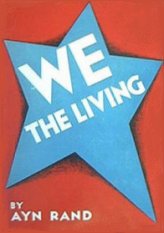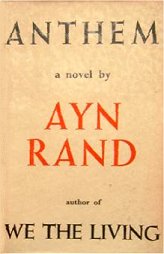

|
<<< Continued from previous page What distinguishes Rand from so many other practitioners of the novel is her bold use of the vehicle for reasons not typically employed - namely, to inculcate a philosophical system. For some of us this spoils things. For me it brings to mind the protracted, tiresome epilogue in Tolstoy's War and Peace, in which the author, after penning one most remarkable stories ever told, attempts to explain his vision of history and how his story illustrates it. Groan. Rand takes this a step further: Instead of tacking on an epilogue, she informs the stories themselves with her teachings, necessarily reducing her characters to near lifeless, if archetypal puppets. Many critics saw through this early on, and perhaps Rand's decision to abandon fiction for non-fiction later in life was in some measure a response. Most early converts to Objectivism leave it behind soon enough, for whatever reason, though a few carry the torch onward, former Federal Reserve Chairman Alan Greenspan being an especially notable example. But there are things afoot here that drive sales notwithstanding, not the least of which is simple nostalgia for one's college days and an urge to recapture something from them. Given our present economic climate, it's also possible that one might revisit the content that was left behind so long ago for present applicability. More factors include the larger-than-life aura Rand exudes, a phenomenon enhanced by none other than how she led her life - an intense and sustained political activism, even the scandalous affair with the much junior Nathaniel Branden - and of course the controversy ever swirling around Objectivism itself. Rand produced only five works of fiction, three novels (We the Living, The Fountainhead and Atlas Shrugged), a play (Night of January 16th) and a novella (Anthem) but there's a more significant body of non-fiction in the form of books, articles, etc., that grow her bibliography from booklet to book. The standard resource to date is Vincent L. Perinn's Ayn Rand: First Descriptive Bibliography, which covers primary materials only.  A bibliography of secondary materials would be a monumental undertaking, given the level of interest over decades, but to date few of them are of much value to booksellers. Readers have little need, I suppose, for books that explain books that are explanations? Rand signatures are semi-numerous in the marketplace and split more or less cleanly into two types, the first being observable up to and including the publication of The Fountainhead in the early 1940s. Note here the somewhat random orientation of the letters, a triangular loop on the "y" and a closed loop on the "R":  A transition occurred sometime later in the 1940s. A more severely vertical orientation then appeared with a loop-less "y" and an open-looped "R":  No doubt a handwriting analyst could have some fun with this, but there's some consensus that would suggest that the triangular loop is evidence of an appetite for sexual experimentation - rumors of Rand's bisexuality, however, are just rumors - and the loop-less "y" as indicative of loneliness. That Rand championed separatism of the individual dovetails with the latter. In any case, it's quite simple to dismiss a second example appearing on an early publication as contemporary to it, and less savvy collectors will appreciate your effort to explain this. MARKETING ANALYSIS: First and foremost, all Ayn Rand fiction is highly collectible, including first and early printings, and all first printings pre-dating her last novel, Atlas Shrugged, will finish deep into three figures unless condition is very poor indeed. Dust jackets will often push things into four figures. Given that the first print run was a whopping 100,000, outcomes for Atlas Shrugged will lag behind this somewhat but are impressive notwithstanding (lower three figures, typically, though four figures is possible in exceptional condition with a dust jacket). Compare this to 19,500 for The Fountainhead. Signatures add hundreds to outcomes, early examples more so. Remember the loops! Along with first printings of Atlas Shrugged, what's most likely to provide consistent income for booksellers are ... [Subscribe or purchase this Author Report for more information.] BIBLIOGRAPHY: 1. We the Living
 1936. New York. The Macmillan Company. "Published April 1936" stated on title page verso. No additional printings. Dust jacket price: $2.50. 3,000 copies. 2. Anthem  1938. London. Cassell and Company. "First Published 1938" stated on title page verso. No additional printings. Dust jacket price: 6s. Second state dust jacket with "Colonial Edition" printed on flap. 3,500 copies. 3. The Fountainhead 1943. New York. The Bobbs-Merrill Company. "First Edition" stated on title page verso. First issue (7,500 copies) bound in red cloth. Second issue (12,000 copies) bound in green cloth. Dust jacket price: $3.00. First issue dust jacket with sixteen Bobbs-Merrill titles on back panel. Second issue dust jacket with photograph of author and three reviews on back panel. [Subscribe or purchase this Author Report for more information.]
Want to read more articles by
< to previous article
Questions or comments?
| Forum
| Store
| Publications
| BookLinks
| BookSearch
| BookTopics
| Archives
| Advertise
| AboutUs
| ContactUs
| Search Site
| Site Map
| Google Site Map
Store - Specials
| BookHunt
| BookShelf
| Gold Edition & BookThink's Quarterly Market Report
| DomainsForSale
| BookThinker newsletter - free
Copyright 2003-2011 by BookThink LLC
|

|
|